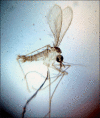Searching for cutaneous leishmaniasis in tribals from kerala, India
- PMID: 20606960
- PMCID: PMC2889671
- DOI: 10.4103/0974-777X.62874
Searching for cutaneous leishmaniasis in tribals from kerala, India
Abstract
Background: In India, indigenous cases of cutaneous leishmaniasis (CL) are mainly confined to the northwestern region. But now, more and more case reports are coming in from other parts of India. In January 2009, a 26-year-old lady residing in a forest area in Thiruvananthapuram district of Kerala State presented with bluish red nodules on her upper extremities, of six months duration, which was clinically more in favor of cutaneous leishmaniasis. She had never gone out of the district of Thiruvananthapuram in her life.
Aim: To investigate whether the patient hails from a new endemic focus of cutaneous leishmaniasis.
Setting and design: An epidemiological investigation in the form of a survey was carried out in March 2009 by a multidisciplinary team among 63 persons residing in the Mele Aamala and Aayiramkala forest tribal settlements in Kuttichal Panchayat of Thiruvananthapuram district.
Material and methods: History taking and clinical examination of 38 persons in the area with special consideration to skin lesions was undertaken. Microbiological and histopathological examination of the skin lesions was done. Breeding places of sand fly and possible reservoirs of Leishmania were also simultaneously investigated.
Statistical analysis used: The data obtained was tabulated as frequency and percentage. Chi-square test was done to find out the statistical significance of differences in distributions.
Results: Out of the 38 persons examined, active lesions were found in 12 persons and six had healed lesions. Tissue samples were obtained from seven out of the 12 suspected cases. Four of them showed Leishman Donovan (LD) bodies in tissue smears. Out of the cultures taken from three patients, one showed promastigote forms in Novy McNeal Nicolle (NNN) medium. Histopathological study was done in five patients and two patients had LD bodies, one had epithelioid cell granuloma and the other two had mixed infiltrate with predominantly macrophages. All the three investigations were carried out in three patients and out of them one showed positivity in all the three investigations and the rest two were positive in tissue smear and histopathological examination. Sandflies collected from the area gave an indirect evidence of its role in the disease transmission in the area.
Conclusion: The clinical, microbiological and histopathological evaluation of the skin lesions was consistent with cutaneous leishmaniasis. But none of the patients gave history of travel outside the district before the onset of the disease and no one had newly moved into this area within the last two years. So this may be considered as probably a new focus of cutaneous leishmaniasis.
Keywords: Cutaneous leishmaniasis; India; Tribal; kerala.
Conflict of interest statement
Figures





Similar articles
-
Cutaneous leishmaniasis caused by Leishmania donovani in the tribal population of the Agasthyamala Biosphere Reserve forest, Western Ghats, Kerala, India.J Med Microbiol. 2015 Feb;64(Pt 2):157-163. doi: 10.1099/jmm.0.076695-0. Epub 2014 Dec 5. J Med Microbiol. 2015. PMID: 25480880
-
Localized cutaneous leishmaniasis due to Leishmania donovani and Leishmania tropica: preliminary findings of the study of 161 new cases from a new endemic focus in himachal pradesh, India.Am J Trop Med Hyg. 2005 Jun;72(6):819-24. Am J Trop Med Hyg. 2005. PMID: 15964970
-
Histological grading patterns in patients of cutaneous leishmaniasis.J Coll Physicians Surg Pak. 2007 Nov;17(11):650-3. J Coll Physicians Surg Pak. 2007. PMID: 18070569
-
Leishmaniasis of the eyelid mimicking an infundibular cyst and review of the literature on ocular leishmaniasis.Int J Infect Dis. 2010 Sep;14 Suppl 3:e230-2. doi: 10.1016/j.ijid.2009.07.024. Epub 2009 Dec 6. Int J Infect Dis. 2010. PMID: 19969498 Review.
-
[Feline leishmaniasis: what's the epidemiological role of the cat?].Parassitologia. 2004 Jun;46(1-2):203-6. Parassitologia. 2004. PMID: 15305717 Review. Italian.
Cited by
-
Human leishmaniasis vaccines: Use cases, target population and potential global demand.PLoS Negl Trop Dis. 2021 Sep 21;15(9):e0009742. doi: 10.1371/journal.pntd.0009742. eCollection 2021 Sep. PLoS Negl Trop Dis. 2021. PMID: 34547025 Free PMC article.
-
Report of a new species of sand fly, Phlebotomus (Anaphlebotomus) ajithii n. sp. (Diptera: Psychodidae), from Western Ghats, India.Parasit Vectors. 2024 Sep 12;17(1):388. doi: 10.1186/s13071-024-06468-2. Parasit Vectors. 2024. PMID: 39267125 Free PMC article.
-
Evaluation of farnesol orally and topically against experimental cutaneous leishmaniasis: In -vivo analysis.PLoS One. 2023 Aug 28;18(8):e0290297. doi: 10.1371/journal.pone.0290297. eCollection 2023. PLoS One. 2023. PMID: 37639393 Free PMC article.
-
Multilocus microsatellite typing reveals a genetic relationship but, also, genetic differences between Indian strains of Leishmania tropica causing cutaneous leishmaniasis and those causing visceral leishmaniasis.Parasit Vectors. 2014 Mar 25;7:123. doi: 10.1186/1756-3305-7-123. Parasit Vectors. 2014. PMID: 24666968 Free PMC article.
-
Prevalence of Neglected Tropical Diseases (Leishmaniasis and Lymphatic Filariasis) and Malaria Among a Migrant Labour Settlement in Kerala, India.J Immigr Minor Health. 2019 Jun;21(3):563-569. doi: 10.1007/s10903-018-0767-9. J Immigr Minor Health. 2019. PMID: 29860672
References
-
- Dedet JP, Pratlong F. Leishmaniasis. In: Manson P, Cook GC, Zumla A, editors. Manson's Tropical diseases. 21st ed. London: Saunders; 2003. pp. 1339–64.
-
- WHO Report on Global Surveillance of Epidemic-prone Infectious Diseases – Leishmaniasis. Epidemic and Pandemic Alert and Response (EPR) Available from: http://www.who.int/entity/csr/resources/publications/CSR_ISR_2000_1leish.... [last cited on 2009 Dec 13]
-
- Leishmaniasis and its control, Monthly Newsletter of National Institute of Communicable Diseases, Directorate General of Health Services, Government of India. Vol 10 Available from: http://nicd.nic.in/cdalert/January-06.pdf. [last cited on 2006]
-
- Lohidakshan MU, Shanmugham Pillai SM, Vijayadharan M, Sarojini PA. Two cases of cutaneous leishmaniasis in Trivandrum. Indian J Dermatol Venereol Leprol. 1988;54:161–2. - PubMed
-
- Muhammed K, Narayani K, Aravindan KP. Indigenous cutaneous leishmaniasis. Indian J Dermatol Venereol Leprol. 1990;56:228–9.
LinkOut - more resources
Full Text Sources
Research Materials

